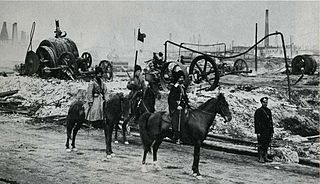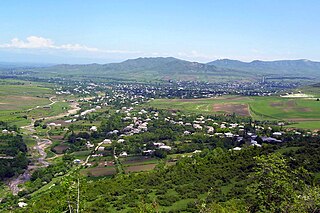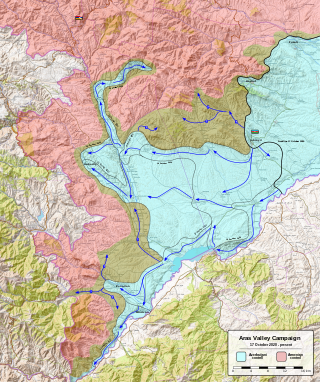
The First Nagorno-Karabakh War was an ethnic and territorial conflict that took place from February 1988 to May 1994, in the enclave of Nagorno-Karabakh in southwestern Azerbaijan, between the majority ethnic Armenians of Nagorno-Karabakh backed by Armenia, and the Republic of Azerbaijan with support from Turkey. As the war progressed, Armenia and Azerbaijan, both former Soviet republics, entangled themselves in protracted, undeclared mountain warfare in the mountainous heights of Karabakh as Azerbaijan attempted to curb the secessionist movement in Nagorno-Karabakh.

The Armenian–Tatar massacres was the bloody inter-ethnic confrontation between Armenians and Caucasian Tatars throughout the Russian Caucasus in 1905–1907. The massacres started during the Russian Revolution of 1905. The most violent clashes occurred in 1905 in February in Baku, in May in Nakhchivan, in August in Shusha and in November in Elizabethpol, heavily damaging the cities and the Baku oilfields. Some violence, although of lesser scale, broke out also in Tiflis.

The Nagorno-Karabakh conflict is an ethnic and territorial conflict between Armenia and Azerbaijan over the region of Nagorno-Karabakh, inhabited mostly by ethnic Armenians until 2023, and seven surrounding districts, inhabited mostly by Azerbaijanis until their expulsion during the 1990s. The Nagorno-Karabakh region was entirely claimed by and partially controlled by the breakaway Republic of Artsakh, but was recognized internationally as part of Azerbaijan. Azerbaijan gradually re-established control over Nagorno-Karabakh region and the seven surrounding districts.
Nagorno-Karabakh is located in the southern part of the Lesser Caucasus range, at the eastern edge of the Armenian Highlands, encompassing the highland part of the wider geographical region known as Karabakh. Under Russian and Soviet rule, the region came to be known as Nagorno-Karabakh, meaning "Mountainous Karabakh" in Russian. The name Karabakh itself was first encountered in Georgian and Persian sources from the 13th and 14th centuries to refer to lowlands between the Kura and Aras rivers and the adjacent mountainous territory.

The region of Nagorno-Karabakh and areas around it are considered to be some of the most heavily mined regions of the former Soviet Union. Mines were laid from the early 1990s by both Azerbaijani and Armenian forces during and after the First Nagorno-Karabakh War. The worst-affected areas are along the fortified former contact line between Azerbaijani and Armenian forces, in particular in the districts of Aghdam, Fuzuli and Jabrayil. According to military experts from both Azerbaijan and Armenia, the ground in those areas is covered with "carpets of land mines." The region has the highest per capita rate in the world of accidents due to unexploded ordnance.
Terrorism in Russia has a long history starting from the time of the Russian Empire. Terrorism, in the modern sense, means violence against civilians to achieve political or ideological objectives by creating extreme fear.

There are no diplomatic relations between Armenia and Azerbaijan. The two neighboring states had formal governmental relations between 1918 and 1921, during their brief independence from the collapsed Russian Empire, as the First Republic of Armenia and the Democratic Republic of Azerbaijan; these relations existed from the period after the Russian Revolution until they were occupied and annexed by the Soviet Union, becoming the constituent republics of Soviet Armenia and Soviet Azerbaijan. Due to the five wars waged by the countries in the past century—one from 1918 to 1921, another from 1988 to 1994, and the most recent in 2016, 2020 and 2023—the two have had strained relations. In the wake of hostilities, social memory of Soviet-era cohabitation is widely repressed through censorship and stigmatization.

The 2008 Mardakert clashes began on March 4 after the 2008 Armenian election protests. It involved the heaviest fighting between ethnic Armenian and Azerbaijani forces over the disputed region of Nagorno-Karabakh since the 1994 ceasefire after the First Nagorno-Karabakh War.

Sadakhlo is a village in Georgia located in the southern part of country in the administrative territory of Marneuli Municipality at the border with Armenia. The village is about 27 kilometres (17 mi) south of the municipal center Marneuli and 50 kilometres (31 mi) south of the capital Tbilisi. It is situated along the left bank of the Debeda river. Sadakhlo is the largest village in Georgia, and is the center of the eponymous administrative community that includes 4 other nearby villages: Burma, Tazakendi, Molaoghli, and Khuldara.
The 1994 Baku Metro bombings was a series of terrorist incidents that targeted the Baku Metro in Baku, Azerbaijan. The first attack was perpetrated at the 20 Yanvar metro station, while the second one took place between the 28 May and Ganjlik stations. As a result of the first attack, 14 people were killed and 49 wounded. The second attack resulted in 13 people killed and 42 injured.
The 1990 Tbilisi–Aghdam bus bombing, also known as 1990 Khanlar bus bombing occurred on 10 August 1990, in the vicinity of Khanlar, when an explosive device blew up in a bus 12.5 km away from Azerbaijan's second largest city, Ganja.
Anti-Azerbaijani sentiment, Azerophobia, Azerbaijanophobia, or anti-Azerbaijanism has been mainly rooted in several countries, most notably in Russia, Armenia, and Iran, where anti-Azerbaijani sentiment has sometimes led to violent ethnic incidents.

The 2016 Nagorno-Karabakh conflict, also known as the Four-Day War, April War, or April clashes, began along the former Nagorno-Karabakh line of contact on 1 April 2016 with the Artsakh Defence Army, backed by the Armenian Armed Forces, on one side and the Azerbaijani Armed Forces on the other.

The bombardment of Stepanakert began on September 27, 2020, the first day of the Second Nagorno-Karabakh War, and lasted throughout the duration of the war. Stepanakert is the capital and largest city of the self-proclaimed Republic of Artsakh, internationally recognized as part of Azerbaijan, and was home to 60,000 Armenians on the eve of the war. Throughout the 6-week bombardment, international third parties consistently confirmed evidence of the indiscriminate use of cluster bombs and missiles by Azerbaijan against civilian areas lacking any military installations in Stepanakert; this was denied by Azerbaijan. The prolonged bombardment forced many residents to flee, and the rest to take cover in crowded bomb shelters, leading to a severe outbreak of the COVID-19 pandemic in the city, infecting a majority of the remaining residents. Throughout the course of the bombardment, 13 residents were killed, 51 were injured, and 4,258 buildings in the city were damaged.

The Aras Valley campaign was a military operation launched by Azerbaijan against the breakaway Republic of Artsakh along the Aras River in the Azerbaijan–Iran border during the Second Nagorno-Karabakh War.
The Susuzluq explosion was a mine explosion in the vicinity of the village of Susuzluq in Azerbaijan's Kalbajar region, which occurred on 4 June 2021. The explosion killed 3 people, two of them journalists, and wounded another 4. This is the first case of journalist death on Azerbaijani territory after the 2020 Nagorno-Karabakh war.
Events of the year 2023 in Armenia.
This is a list of individuals and events related to Azerbaijan in 2023.
In the aftermath of World War I and during the Armenian–Azerbaijani and Russian Civil wars, there were mutual massacres committed by Armenians and Azerbaijanis against each other. A significant portion of the Muslim population of the Erivan Governorate were displaced during the internecine conflict by the government of Armenia. Starting in 1918, Armenian partisans expelled thousands of Azerbaijani Muslims in Zangezur and destroyed their settlements in an effort to "re-Armenianize" the region. These actions were cited by Azerbaijan as a reason to start a military campaign in Zangezur. Ultimately, Azerbaijan took in and resettled tens of thousands of Muslim refugees from Armenia. The total number of killed is unknown.










